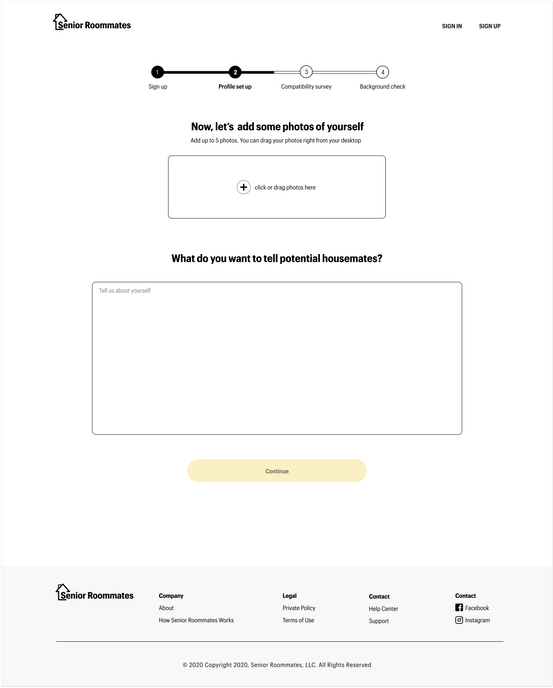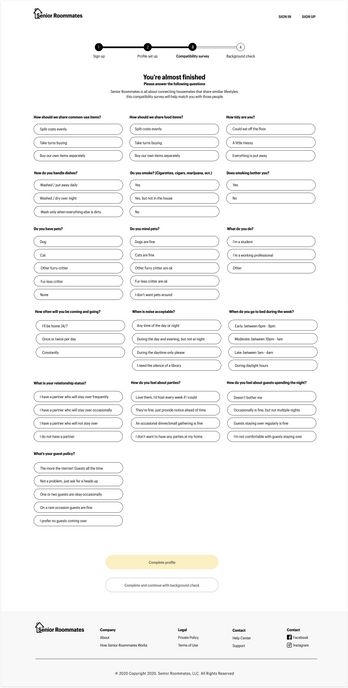top of page
OVERVIEW
Senior Roommates is a service platform that connects senior (as in senior citizen) homeowners with homeseekers. I was task to design a responsive website to help form those connections easier and more efficiently.
THE CHALLENGE: To design a homeshare and homeseeker listing website that matches the homeowner and the homeseeker based on shared lifestyles. Also, to design the sign up, profile, compatibility survey and background check application process.
MY ROLE & DURATION: UX/UI designer with the following key responsibilities:
A total of 80 hours

RESEARCH
To help me define the set problems I first wanted to understand the motivations and pains of home sharing for older adults. Research methodologies used in such discoveries are: market research, competitive analysis and user interviews.
RESEARCH GOALS: Learn about the demographics of the baby boomers. Gain an understanding of what drives and motivates older adult homeowners to seek roommates.
SENIOR LIVING DEMOGRAPHICS:
In the U.S., 27% of adults that is 60 and older live alone. Many of which are single, divorced, widows, or widowers. 70% of those older adults that do live alone are women. Baby boomers that are in retirement or about to enter retirement will need to live on fixed income. Social security benefits for baby boomers will average out to be $1503 per month in 2020. 1/3 of older adults that are 50+ yrs old pay more than 30% of their income for housing.
BENEFITS OF SENIOR HOMESHARING:
Having a roommate can help ease financial burden on both the homeowner and the homeseeker. Homeshaing can provide companionship as well as a sense of security knowing they are not alone in the case of any emergency situation. Also, having a roommate/s can provide physical help around the home.

USER INTERVIEWS: for these interviews I recruited 3 participants (2 females and 1 male) ages 60-70 yrs old. All of whom are homeowners and are in retirement or about to retire. The purpose of these interviews is to confirm certain assumptions found in the secondary research and to uncover new motivations, needs and pains a home owner may have with home sharing.
HOMESHARING MOTIVATIONS & NEEDS:
The primary motivation the participants would consider home sharing with roommates is to have another income stream if they're retired that would help lift the financial burden of paying the mortgage or rent. Other reasons participants would consider roommates is to have consistent company around to talk to, to have a sense of security and to have help around the house.
HOMEOWNER ISSUES & PAINS:
Couple of the participants mentioned they would be hesitant to welcome roommates into their home because they are living a certain way. So they said they would want the roommate to share similar lifestyles. The participants also said they would only feel comfortable home sharing with people they know or with someone that a close acquaintance can vouch for.

PERSONA:
After synthesizing all the research I created a persona that I can empathize with and to keep in mind as I proceed further into the product design process.

EMPATHY MAP:
This empathy map gives more context to the persona. It captures the persona attitudes and behaviors that will help us align the product for the end users.
Research
Define & Ideate
DEFINE & IDEATE
Taking all the research conducted into consideration. I then drafted three "How Might We" statements. Afterwards, a quick short storyboard was sketched to generate a possible problem solutions.
Problem Statements:
How might we help the user (homeseeker) find the right home shares that have similar lifestyles?
How might we help the users feel safe using the platform?
How might we help the users communicate safely with each other?
STORYBOARD:
The storyboard generated here is a quick visualization of the various pages I started to think about when addressing the problem statements.

INTERACTION DESIGN
Taking the initial ideas generated during the ideation phase I then made the user flow and a first set of mid fidelity wireframes. The user flow identifies the pages the user will interact with to complete certain tasks and the first set of wireframes illustrates those pages in greater detail.
USER FLOW:
This version of the user flow is the final iteration after a couple of revisions made during the interaction, user interface design & testing phases. The background check part of the flow process was not confirmed or determined at the start of the interaction design phase.

Interation Design
USER INTERFACE DESIGN
After considering all the feedback received from the mid fidelity wireframes I was ready to move forward with the high fidelity wireframes.
UI KIT
Since positive comments were received on the logo mock up on the mid fidelity wireframes no further iterations were needed. The attributes that would define the logo - simple, clean and approachable.




RESPONSIVE WIREFRAMES



HIGH FIDELITY WIREFRAMES
User Interface Design
PROTOTYPE & TESTING
To test the usability of the designs, I created a high fidelity prototype using Figma and conducted the tests over Zoom. I recruited 4 participants (2 females and 2 males) from ages 30-65 yrs old. Each were given the following tasks as I observed the participants perform each task.
TASK 1: SIGN UP
Task details
Sign up as a home seeker using a phone number and create your initial user profile that includes pictures and a description. Also, complete the compatibility survey which is part of the basic profile set up.
TASK COMPLETION RATE
100%
ERROR FREE RATE
95%
TESTING OBSERVATIONS
Before doing the assigned task I observed each participant scroll and quickly ready through the home page headlines. The participants found the sign up process easy. Most said the process felt and looked familiar. They liked the compatibility survey and the questions asked to understand a user lifestyle.
TASK 2: COMPLETE THE BACKGROUND CHECK APPLICATION
Task details
If you see an option to do a background check please proceed with the process. Please feel free to make any comments.
TASK COMPLETION RATE
100%
ERROR FREE RATE
100%
TESTING OBSERVATIONS
Although all the participants completed this task successfully without any errors I observed a couple of the participants almost skipping this task altogether since it was an optional step in the sign up process. Afterwards, one of the participants said she likes the option of having a background check but she would be hesitant to apply for one herself because of the information needed to conduct one. Another participant wanted to know who was conducting the background checks.
TASK 3: FIND A HOME SHARE AND CONTACT THE HOME OWNER
Task details
Once you've completed the background check application find a home share listing that you have a high compatibility match with and make contact with home owner.
TASK COMPLETION RATE
100%
ERROR FREE RATE
95%
TESTING OBSERVATIONS
The participants had no issues locating the home share listing with the highest compatibility match and contacting the home owner with the internal messaging system. However, I did observe one participant on the home share profile page click on the share button first before he realized there was a message button to make contact with the home owner. All participants felt there was enough on the listing and home owner pages to be informative.
Prototype & Testing
NEXT STEPS
Now that I validated the design up to a certain user flow. The next step would be to define the interactions of other user flows and expanding the design of the website while continuing to iterate and test as new pages are created.
MORE PROJECTS
A responsive e-commerce website for a new airliner
Enhance the connection with friends
bottom of page






























